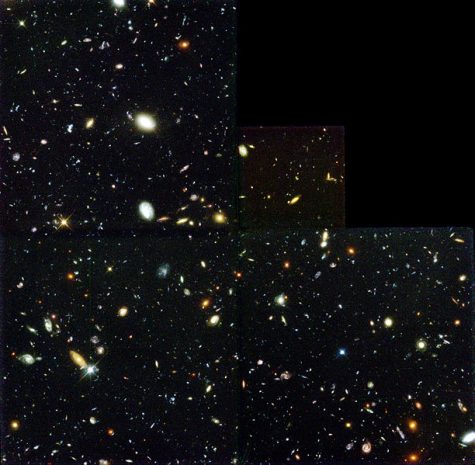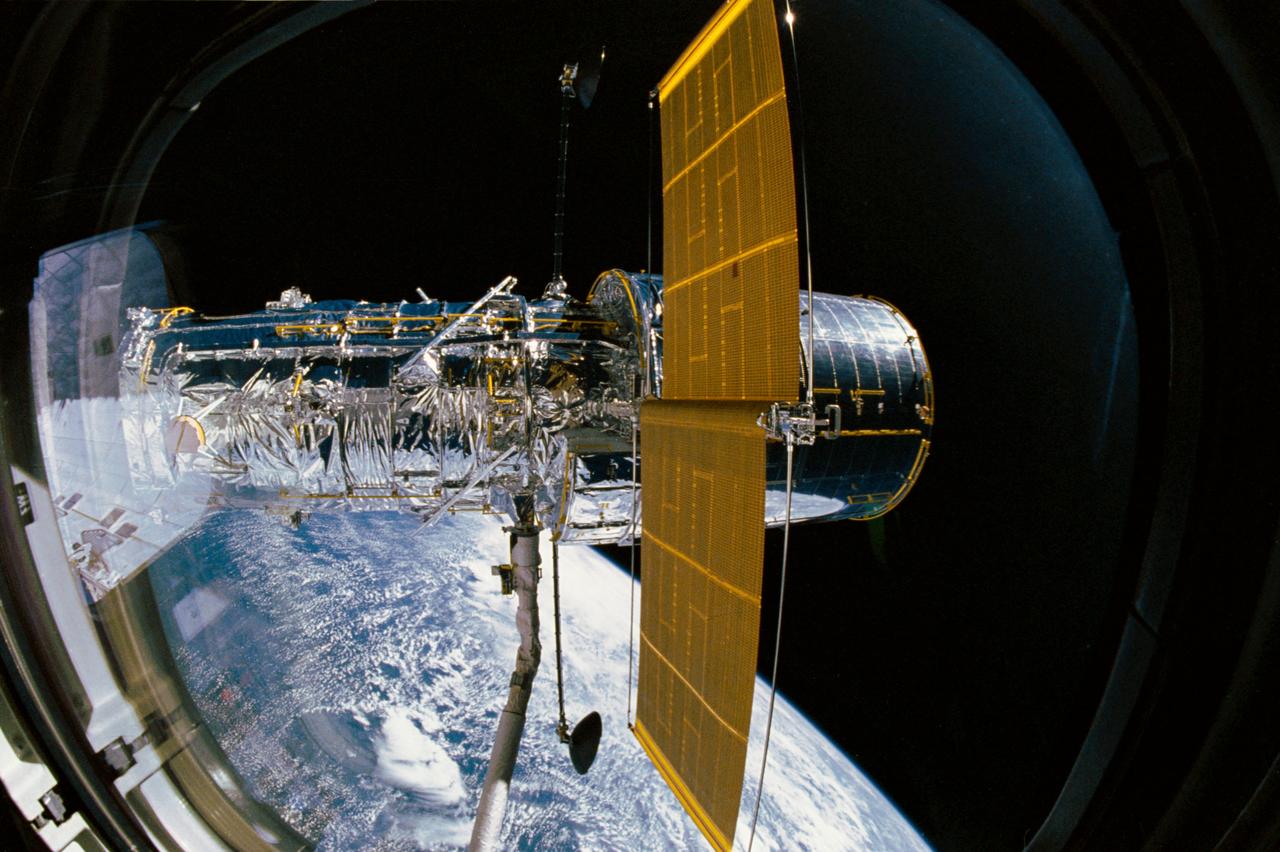This spring sees the anniversary of one of the most scientifically productive instruments in human history. Today, April 24, celebrates the 30th year of the Hubble Space Telescope’s deployment in orbit. In its long-lived 30 years, Hubble has redefined our view of the Universe multiple times through its captivating shots of the cosmos.
At the dawn of the Space Age, scientists spoke out about the prospect and benefits of a large telescope in space. In 1946, astrophysicist Lyman Spitzer wrote that a telescope in space would be free of the effects of Earth’s atmosphere such as weather conditions or atmospheric refraction.
Riordan science teacher Tony Dunn ’82 described the utility of a telescope in space, “The atmosphere blurs our view of the universe. It also filters specific wavelengths of light. That’s why professional observatories are built on mountain peaks. They want to get above as much atmosphere as possible.” Free of the impediments of the atmosphere, a telescope would be able to take images of space at different wavelengths at any time with unprecedented clarity. “Hubble takes that to the next level. It is in space.”
The project to create a large orbital telescope slowly gained support. In 1969, the National Academy of Sciences expressed its support. In 1974, a group of astrophysicists and engineers met for the first time to workshop the project, developing key concepts such as its technological requirements and cost. However, after the Apollo 11 program in 1969, NASA struggled to receive additional support and funding from the government.
Despite this setback, the group, named the Large Space Telescope (LST) Science Working Group, still made developments on the LST Project. The ESA, or European Space Agency, gave monetary contributions to the project. NASA recommended that some of the telescope’s technology is made with interchangeable parts. Along with this, the newly introduced and reusable Space Shuttle was proposed to be able to carry the telescope into orbit and return to it at minimal cost. These progressions allowed the LST to be serviced in orbit and continue operating for 15 years.
Finally, in 1977, Congress approved funding for the Large Space Telescope. Grinding of the primary mirror began in December of 1978. In 1983, the telescope was named after renown American Astronomer Edwin Hubble, who is credited for changing our view of the Universe by discovering other galaxies beside our own Milky Way and that these galaxies are receding, showcasing an expanding Universe. From then on, the Large Space Telescope gained its iconic title: the Hubble Space Telescope.
The telescope was ready for launch in 1985. However, disaster struck after the Challenger space shuttle exploded 73 seconds into launch on Jan. 28, 1986, killing all seven on board. NASA grounded the space shuttle fleet for two years while updating the HST. Finally, on April 24, 1990, the space shuttle Discovery brought Hubble into orbit, fulfilling decades of work and research.
But that was not the end of troubles for NASA’s new Eye in the Sky. Shortly after its first images, NASA noticed that the objects in the images were blurry. This was because of a flaw in the primary mirror: its curvature was off by 2 microns, or 1/50th of a human hair.
Dunn recalled the news of the flawed mirror, “As a child, I remember hearing that the future of astronomy lies with space-based telescopes because of the atmosphere’s effects… A few weeks after launch, Hubble sent back its first pictures, and they were disappointing. News of the flawed mirror was devastating.”
NASA had to act to rectify this flaw in the mirror, not by changing the mirror, but by introducing new instruments such as the Corrective Optics Space Telescope Axial Replacement (COSTAR) instrument and Wide Field and Planetary Camera 2 (WFPC2) on Hubble’s first servicing mission in 1993. According to NASA, the corrective instruments compensated for the flawed mirror, “allowing the telescope for the first time to cleanly resolve faint structures as small as 30 light-years across in a galaxy tens of millions of light-years away.”
Now, 30 years into its service, which is double its initially expected lifetime of 15 years, Hubble has an impressive run of images, feats, and discoveries that, much like Edwin Hubble, redefined the Universe and our place in it.
Hubble has taken numerous photos of galactic and nebulous structures that capture the wonder and imagination of many, being circulated through the masses and media throughout the globe. Images such as the Pillars of Creation, the Helix Nebula, the Sombrero Galaxy, and the less artistically named NGC 1300 display the intricacies and structures of fuzzy blobs and Messier objects that were never seen in such detail before.
With its beautiful images comes unprecedented discoveries. Through using observations made by Hubble, scientists have seen comets impact Jupiter, demonstrated the existence of supermassive black holes in the heart of most galaxies, found the missing half of the Universe’s hadronic (normal) matter in the space between galaxies, mapped a model of Pluto’s surface, discovered Pluto’s moons as well as others in the Kuiper Belt, and estimated the age of the Universe.
Hubble also explored the unknowns in the Universe by investigating the baffling effects of mysterious phenomena scientists call dark matter and dark energy. Hubble’s observation of galaxies allows for the measurement of gravitational mass attributed to dark matter as well as the increasing rate of expansion, named the Hubble constant, attributed to dark energy.
Perhaps what is arguably Hubble’s greatest discovery happened when scientists took a shot in the dark. In 1995, scientists pointed Hubble to look at a dark patch of sky slightly above the Big Dipper about the size of a dime seen 75 feet away. The segment of sky initially appears nearly empty, devoid of all objects except a few foreground stars. However, after a total of 10 days of exposure, Hubble produced one of Dunn’s favorite images: “Looking at an area of sky about the size of a grain of sand held at arm’s length, Hubble spotted over 3000 galaxies, each home to billions of stars.”

The Hubble Deep Field taken in 1995 and depicting over 3,000 galaxies.
This image, known as the Hubble Deep Field, allows astronomers to peer back in time. The distance of these galaxies corresponds with how far back they are seen in time. The farthest galaxies in the Hubble Deep Field give us an image of them only a couple of billion years after the Big Bang. From this, astronomers have gained information about star and galactic formation throughout the cosmos. Hubble has repeated this procedure in separate dark patches in the sky throughout its history in orbit, bringing about the total estimate of about 125 billion galaxies in the observable Universe.
The scientific contributions of the Hubble Space Telescope are not easily matched. According to NASA, astronomers used its data to write over 16,000 peer-reviewed publications, which have been referenced in other texts 800,000 times. Despite its rocky start, every current astronomy textbook has contributions from the telescope, and its images of space have become a cornerstone in our view of space throughout society. As the orbiting telescope enters its third decade, NASA and astronomy geeks everywhere will make sure to celebrate our first Eye in the Sky.

Nebulae NGC 2014 and NGC 2020 are imaged in “Cosmic Reef”, celebrating Hubble’s 30th Anniversary.
To commemorate its 30th anniversary, NASA released an image of a star factory present in the Large Magellanic Cloud, a satellite galaxy of the Milky Way 163,000 light-years away. The image, named “Cosmic Reef” depicts two vibrant nebulae whose structures shaped by the radiation of very massive stars resemble a coral reef.
Andrew Fraknoi, a seasoned and award winning professor who currently teaches Astronomy at the University of San Francisco, had this to say about the Hubble spacecraft, “NASA claims that the Hubble is the most productive telescope in the history of astronomy. The agency’s public information department has a history of overstatement, but in this case, I believe they are quite right. The data and images that have come back from the Hubble have done more to advance astronomy than any other instrument. In telescope years (they’re like dog years) this is an aging telescope, and it’s wonderful to see it continue to work and make discoveries.”









